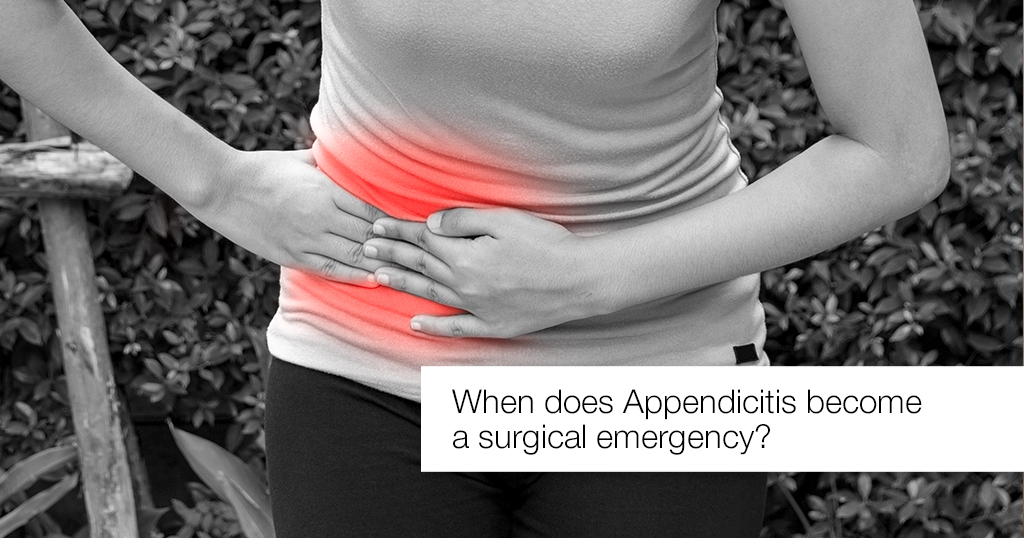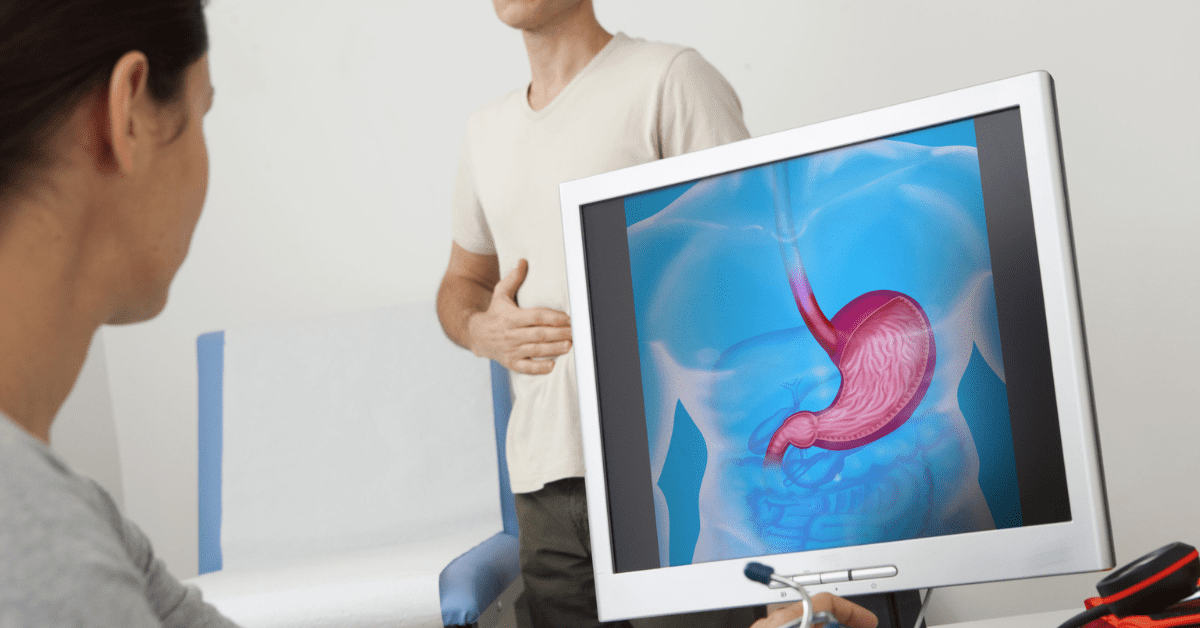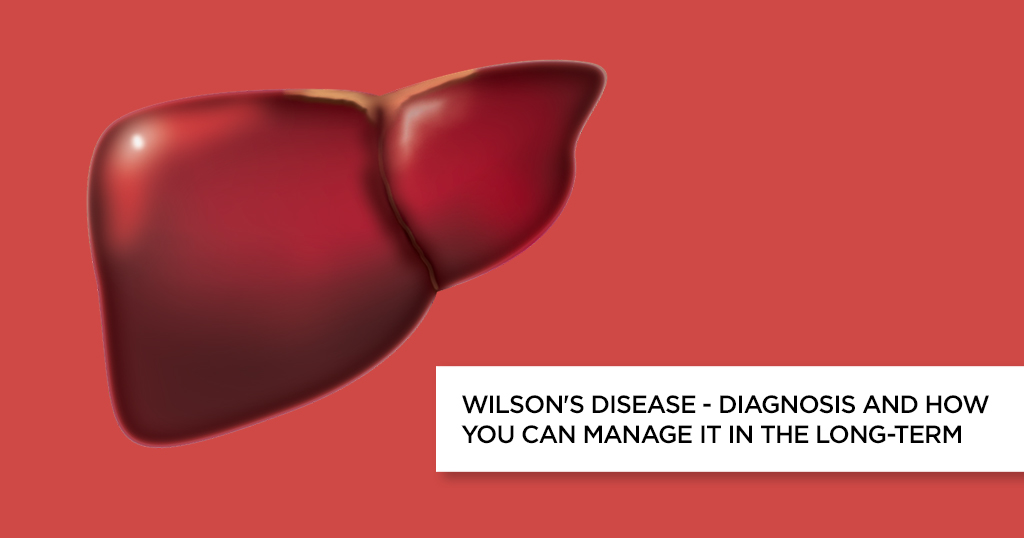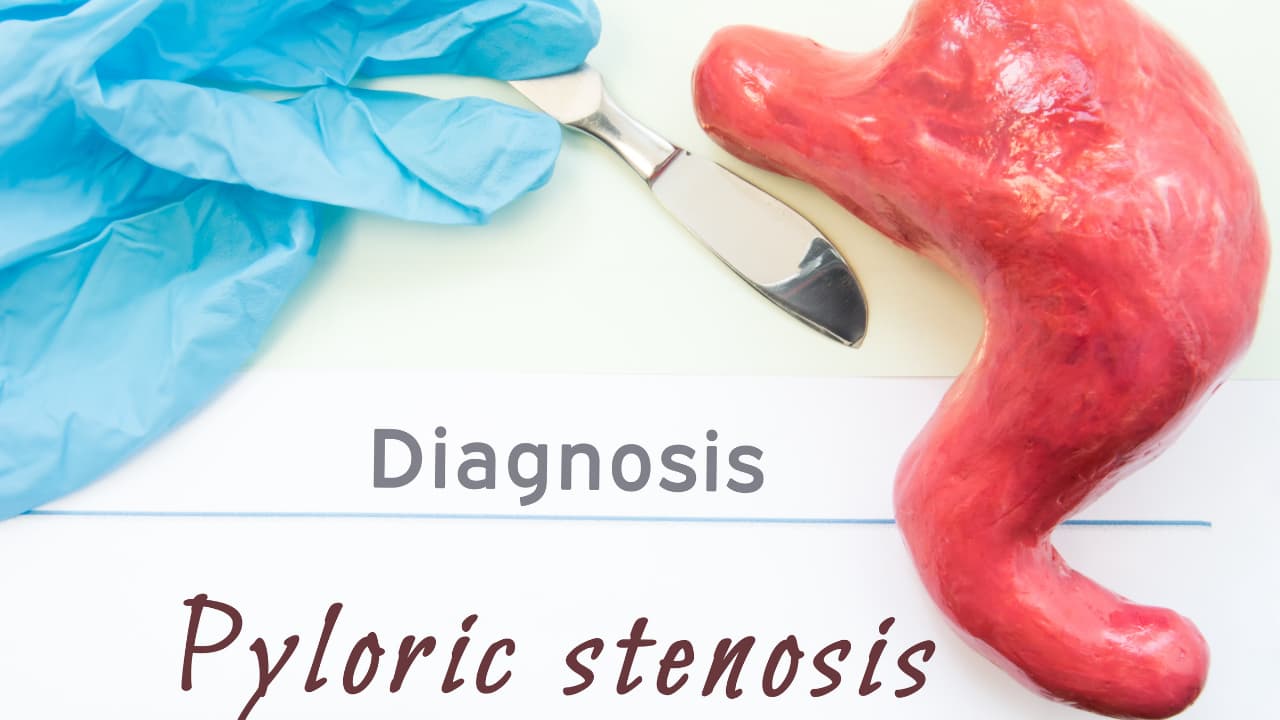All About Appendicitis


Overview
The appendix is a finger-like pouch attached at the beginning of the large intestine and has no known purpose in the human body. Appendicitis is the corresponding condition of an inflamed appendix filled with pus that causes unbearable pain. The pain is concentrated in the lower right abdomen. In certain cases, it starts around the navel. As the inflammation increases, the pain becomes severe, and appendicitis turns acute. Most of these people affected by this condition are between the ages of 10 and 30. So, let us take a closer look at what appendicitis really is.
What is Appendicitis?
Appendicitis is a medical emergency that requires immediate attention. It is also the most common cause of abdominal surgery. Appendicitis can occur at any age and equally affects both men and women. However, it is slightly more prevalent in men who are 15 to 25 years old. Recent studies have shown a reduction in the number of cases of appendicitis in western countries. The incidence in Asian and African countries may be lower. But actual figures from these countries are not available. The prevalence of appendicitis is low in cultures where a high-fiber diet is consumed regularly.
Appendicitis occurs when a blockage of the appendix causes it to be infected and inflamed. The appendix becomes swollen, infected, and painful in this situation. The inflammation can also spread to the body structures surrounding the appendix.
The resulting pain and symptoms can mimic other conditions such as urinary tract infections or stomach ulcers. However, appendicitis is an emergency condition that requires immediate treatment. Diagnosis of appendicitis relies heavily on the experience of the doctor. The diagnosis is made from the physical signs of the patient and investigations. Pain in the right lower region of the abdomen is the most common symptom associated with appendicitis. Investigations such as ultrasound and laboratory tests are carried out for further evaluation and clear observation of appendicitis. The treatment of appendicitis involves medications to control the infection and removal of the appendix by surgery. Surgical removal of the appendix is called an appendectomy. If appendicitis treatment is delayed, the patient may develop complications such as perforation, abscess, and peritonitis. Fortunately, one can live without appendicitis.
Appendicitis among kids
Since anyone can experience appendicitis, children are no less vulnerable than adults. This disease is common among 15- to 30-year-olds. If a child or a teenager is suffering from appendicitis, the pain will usually occur in the stomach near the navel. The pain may become severe and move to the lower right side of the stomach along with the following symptoms:
It is important to get your child treated if your doctor believes your child has appendicitis. If it is not diagnosed in approximately 48 hours, there are chances that your child’s appendix may burst, spread, and increase tremendously. It is always suggested to consult your doctor if your child is complaining of appendix-like symptoms, such as fever, vomiting, and poor appetite, as it has many repercussions that may not be good for your child.
As soon as you take the child to a doctor, the doctor may diagnose the symptoms and have your child undergo a few tests such as:
- CT scan
- Ultrasound
- Imaging test
- Blood test
- Urine test
There may be other tests that help your doctor understand the root cause of your child’s symptoms.
Causes
In certain cases, the exact cause of appendicitis is not known. Generally, appendicitis is caused when there is a blockage in the appendix. This blockage or obstruction in the lining of the appendix results in infection. The bacteria start to multiply rapidly, making the appendix swollen, inflamed, and filled with pus. If not given immediate attention, it could lead to rupturing of the appendix. Various factors could potentially block your appendix, such as:
- Appendicitis usually results from an obstruction of the appendix by fecal mass, stricture (narrowing), presence of foreign objects, worms, enlargement of lymphoid tissue, infections, injuries, and tumors.
- The presence of fecal mass, foreign body, or viral infection causes swelling and irritation in the appendix. The blockage in the appendix causes increased mucus production, which exerts greater pressure on the appendix walls. The high pressure on the luminal wall of the appendix causes thrombosis (formation of a blood clot) of the small blood vessels.
- The inner lining of the appendix normally contains several lymphoid tissues. These are collections of immune cells called lymphocytes. These lymphoid tissues can become enlarged in diseases of the intestine like inflammatory bowel disease, measles, amoebiasis, and viral infections. This can also cause blockage of the appendix.
- Parasites like threadworms and flukes can also cause blockage of the appendix. Blockage of the appendix has also been shown in injuries like shotgun wounds to the abdomen and by a misplaced intrauterine contraceptive device like CuT. Infections such as tuberculosis and cancers can also result in appendicitis.
- The increasing pressure reduces blood flow to the tissue. Adequate blood supply is required for the cells to remain healthy. A lack of blood supply causes cell death and necrosis of the appendix.
- When this happens, bacteria can multiply within the tube of the blocked appendix. As the bacteria multiply, immune and inflammatory cells such as white blood cells (WBC) accumulate at the site of the infection, and the whole process results in inflammation.
- The inflammation can cause the appendix to swell and become painful. It can also spread to the tissue and structures immediately surrounding the appendix and cause infection, thrombosis, and necrosis.
- If left untreated, the infected or inflamed appendix will burst (perforate), spilling the infectious material into the abdominal cavity and result in peritonitis. Sometimes, a pus-filled abscess (a pocket of pus built up in the tissues) is formed outside the inflamed appendix. Due to these complications, appendicitis is an emergency condition requiring immediate surgical removal of the appendix.
Symptoms
Appendicitis symptoms form a classic triad of stomach pain, vomiting, and fever. But this typical presentation may not be presented in all cases.
Abdominal pain is the most common symptom of appendicitis. Typically, the pain starts in the middle of the abdomen and later shifts to the lower right side, where the appendix is usually located. The pain may worsen if the area where the appendix is located is pressed or while coughing or walking. In acute appendicitis, the affected individual experiences excruciating pain that causes him to bend his body by folding his legs to the chest.
The anatomic position of the appendix varies considerably between individuals. The location of the pain associated with appendicitis and the associated symptoms can also vary accordingly. An inflamed appendix near the urinary bladder may irritate the bladder and cause painful urination. If the appendix extends behind, inflammation can irritate the nerves and muscles behind and cause difficulty while walking.
Other symptoms of appendicitis are
- Fever
- Nausea and vomiting
- Loss of appetite
- Pain around the navel
- Bloating
- Frequent and painful urination
Appendicitis symptoms vary in different individuals, and the duration of the inflammation also causes the symptoms to vary. Depending on the duration of the symptoms and the presence of complications, appendicitis may be classified as acute, chronic, recurrent, or complicated.
Acute appendicitis
Acute appendicitis occurs when symptoms appear suddenly and with severe intensity. It lasts for 24 to 48 hours. This is the most common reason for abdominal surgery in appendicitis.
Chronic appendicitis
It occurs when the inflammation of the appendix remains undiagnosed, and the symptoms last for up to 3 weeks. The symptoms may appear and disappear. Usually, chronic appendicitis is diagnosed when the intensity of pain increases and the patient presents like one would in acute appendicitis.
Recurrent Appendicitis
It is diagnosed when a patient has multiple episodes of lower abdominal pain due to appendicitis.
Complicated appendicitis
If left untreated, the infected or inflamed appendix will either burst or perforate, spilling the infectious material into the abdominal cavity. Complicated appendicitis occurs when an appendix bursts due to increased pressure within it or when the appendix loses blood supply and becomes gangrenous. An appendicular abscess is formed when pus collects within a sac in the region near the appendix.
An appendix with an abscess can also perforate or explode. The infectious material can spread within the abdominal cavity and cause peritonitis (inflammation of the inner wall of the abdomen).
A few other conditions may mimic the symptoms of appendicitis. These include
- Infections of the uterus and the surrounding structures
- Stones in the urinary tract
- Urinary tract infections
- Endometriosis
- Infection of the intestines
- Gallbladder stone and infection
Risk Factors
- Age: The risk of appendicitis is more in adolescents and young adults (15 to 25 years).
- Gender: Males have a greater risk than females.
- Infection: Gastrointestinal infections increase the risk of appendicitis.
- Trauma: Internal injury to the appendix increases the risk of appendicitis.
- Low fiber diet: A low fiber diet causes constipation and some of the fecal matter to become lodged in the appendix, leading to appendicitis.
Diagnosis
Appendicitis is diagnosed by a doctor by taking a patient’s history, conducting a physical examination, and ordering medical investigations.
- Physical examination
During the physical examination, the doctor checks vital signs such as blood pressure, body temperature, rate of respiration, and heartbeat. The doctor would also conduct a detailed examination of the abdomen and locate the site of pain. Patients with appendicitis have a fever, increased heart rate, pain in the right lower abdomen, and reduced movement of the intestines. If your doctor suspects you have appendicitis, he/she will check for tenderness in the lower right side of the abdomen, along with swelling and rigidity. Once the doctor thoroughly assesses you physically, he/she will prescribe tests based on the visible signs of appendicitis to ascertain the diagnosis. This also helps doctors understand if there are any other reasons for the signs and symptoms you are experiencing.
There is no particular test to identify appendicitis. If the doctor does not find any other reasons for the signs and symptoms you have, he/she may conclude you have appendicitis.
- Blood Test
The blood is tested to determine the white blood cell (WBC) count. An increase in WBC count is a common indication of infection. Along with WBC, a complete blood count may also be prescribed to you by your doctor. To undergo this test, you will have to go to a lab technician, and they will collect a sample of your blood to analyze and detect the cause.
There have been several cases where an ectopic pregnancy has been mistaken for appendicitis. It occurs when a fertilized egg implants itself inside a fallopian tube instead of the uterus. It is a serious medical emergency. If the doctor suspects this, you may be asked to take a pregnancy test. They may also perform a transvaginal ultrasound to understand where the fertilized egg has been implanted.
- Pelvic Exam
Pelvic inflammation can be another reason why you experience symptoms. This usually happens only to females. It is also referred to as an ovarian cyst that affects your reproductive organs. During this examination, the lab technician will inspect your vagina, cervix, and vulva and also manually inspect your uterus and ovaries. They will collect a sample of tissue for this test.
Other laboratory tests may be required to eliminate diseases of abdominal organs such as liver and kidney or detect complications. These tests include:
- CRP or C-reactive protein is elevated in complicated appendicitis.
- Urine Test is performed to detect urinary tract infections and kidney stones. These can also mimic symptoms of appendicitis. Pus cells can appear in the urine in some cases of appendicitis. This test is done as appendicitis is often accompanied by a bacterial infection in your urinary tract, or it may be inside other abdominal organs, which may cause your signs and symptoms. To understand this, your doctor will order a urine test, which will be collected by the lab.
- Liver function tests
- Amylase test to detect diseases of the pancreas, which can imitate appendicitis.
- Imaging test
- Abdominal ultrasound: The ultrasound is the initial investigation of choice in patients suspected of appendicitis. A sociologist uses an ultrasound machine to view the appendix and detect the presence of complications.
- CT Scan: A CT scan is more sensitive than an ultrasound. It can detect appendicitis in patients who present with atypical symptoms and in cases where the appendix is located behind the large intestine.
- X-ray (barium enema): It helps the doctor examine the patient’s rectum, large intestine, and the lower part of the small intestine. A fluid called barium is given to the patient in the form of a rectal enema. Then an X-ray of the abdomen is performed to examine the abdomen, obstruction in the appendix, and detect non-filling appendix. This test is not widely performed now.
Treatment for Appendicitis
In certain rare cases, appendicitis may get treated even without surgery. But in most cases, one needs to undergo surgery for appendix removal and get the condition cured. This surgery is known as an appendectomy. Depending on your medical condition, your doctor will recommend a treatment plan for your appendicitis. It may be one or more of the following:
- Surgery
To treat appendicitis, a surgical procedure known as appendectomy is performed. This procedure involves the surgical removal of the appendix. If the appendix bursts, the abdominal cavity is cleaned out. Though this surgery has certain risks, the risks are lower than the risk of leaving appendicitis untreated. The surgery could be done in a minimally invasive manner, such as laparoscopy. In some cases, open surgery is needed if the abdominal cavity has to be cleaned, which is required if the patient has tumors in the digestive system.
a) Open appendectomy
During an open appendectomy, a single incision is made in the lower right area of the abdomen to remove the appendix. However, this technique has been widely replaced by laparoscopic surgery.
b) Laparoscopic appendectomy
Laparoscopic surgery requires smaller incisions and is less invasive. The surgeon makes three small incisions (each 1/4 – 1/2 inch) and inserts a laparoscope (a tiny telescope connected to a video camera) through a cannula into one of the incisions. It helps the surgeon have a magnified view of the internal organs on a television monitor. Several other cannulas are inserted through the other incisions, and the appendix is removed. Laparoscopic surgery involves smaller incisions, and the recovery period is shorter.
Pain medications and antibiotics may be prescribed after the surgery.
What does a patient have to do before undergoing an appendectomy?
If a patient is scheduled for an appendectomy, he or she has to follow these suggestions to prevent complications:
- Avoid eating or drinking anything 8 hours before the surgery.
- Give complete information about your past health to the surgeon.
- Inform the surgeon if you have sensitivity to any medication or latex.
- Inform the surgeon about all the medications and supplements you take.
- Inform the surgeon if you take aspirin or anticoagulant medications, as they affect blood clotting. The surgeon may ask you to stop taking the medication before the surgery.
What should the patient do after discharge?
- The patient should take proper care after being discharged from the hospital. It helps prevent infections and facilitates early recovery.
- Avoid tiring activities.
- Keep the incision clean and dry.
- Take adequate rest until the doctor advises the patient to return to work and normal activities.
- Consult the doctor immediately if the patient has fever, vomiting, pain, and redness at the site of incision or any other symptoms.
- Drainage
If the appendix has burst, leading to the formation of an abscess around it, the abscess needs to be drained out. This is done by placing a tube through the skin into the abscess. Appendectomy is done a few weeks after the drainage. - Lifestyle remedies
Post appendectomy, you need to follow certain measures to help the body heal and prevent a recurrence. You need to avoid engaging in strenuous activity for the initial recovery phase. You need to place a pillow or provide support to your abdomen when you laugh or cough or even when you make certain movements. You should consult your doctor if the pain relievers are not helping. You need to rest when you feel your body is asking for it. Drinking lots of fluids is necessary. Your doctor may also suggest you take fiber supplements. Also, start increasing your activity gradually, such as going for short walks. Get up and move only when you are completely ready.
Recovery from Appendicitis treatment
There are many factors on which your recovery depends, such as your overall health, if you’ve faced any complications from appendicitis or the surgery, or maybe even a specific type of treatment you received. If you had laparoscopic surgery for the appendix removal, you might be discharged from the hospital in a few hours post-surgery.
But if you had open surgery, the chances are that you will have to spend a few more days in the hospital, receiving proper recovery. Open surgery is highly invasive compared to laparoscopic surgery, and it requires more aftercare.
Prevention
There is no sure way of preventing appendicitis, but you may be able to lower the risk of developing this disease. It is seen that appendicitis is less common in countries where people consume high-fiber diets. Eating a high-fiber diet may help the body create softer stools, which are less likely to cause appendix blockage, and thus, appendicitis. Foods rich in fiber include:
- High-fiber diet: Including food rich in fiber, such as sweet potatoes, flax seeds, raw almonds, mushrooms, etc., will help prevent appendicitis. Diet rich in fiber content helps prevent the obstruction of the appendix by fecal matter.
- Immediate medical care: In the case of symptoms that may suggest appendicitis, approaching a doctor and following medical advice can prevent the complications of appendicitis from developing.
- Dietary fiber is said to reduce the blockage of the appendix by fecal matter. Such foods include fruits, vegetables, oatmeal, whole wheat, whole grains and brown rice, lentils, beans, split peas, and other legumes.
Conclusion
It is of utmost importance that you consult a doctor if you experience even the slightest symptoms of appendicitis. This is a condition that can quickly become a medical emergency. So, recognizing this serious condition promptly and administering the required treatment is crucial.
Frequently Asked Questions (FAQs)
What are the long-term consequences of an appendectomy?
No long-term complications are associated with an appendectomy. You can resume your work 2 to 6 weeks after the surgery. However, it is important to follow a healthy lifestyle for good health.
Is surgery the only method to treat appendicitis?
No. Mild appendicitis can be treated with antibiotics and painkillers. However, patients with severe appendicitis need surgical removal of the appendix to prevent further complications and infections.
Which doctor should I consult for appendicitis?
You should consult a physician, a general surgeon, or a gastroenterologist for appendicitis.
Can appendicitis occur during pregnancy? If yes, what is the treatment?
Appendicitis may happen around the second or third trimester of pregnancy. It may cause fetal loss due to exposure to infectious fluids. The diagnosis and treatment remain the same for a pregnant patient or any other patient. However, additional care will be required. The surgeon, general physician, and gynecologist will closely monitor the patient.
Which conditions can cause similar symptoms as those seen in appendicitis?
Meckel’s diverticulitis, pelvic inflammatory disease (PID), inflammatory diseases of the right upper abdomen, right-sided diverticulitis, kidney diseases, and ectopic pregnancy are some conditions that mimic the symptoms of appendicitis.
Apollo Hospitals has the best appendicitis treatment doctors in India. To find out the best appendicitis doctors in your nearby city, visit the links below:
© Copyright 2024. Apollo Hospitals Group. All Rights Reserved.
 +91 8069991061
Book Health Check-up
Book Health Check-up
Book Appointment
Book Appointment
+91 8069991061
Book Health Check-up
Book Health Check-up
Book Appointment
Book Appointment







